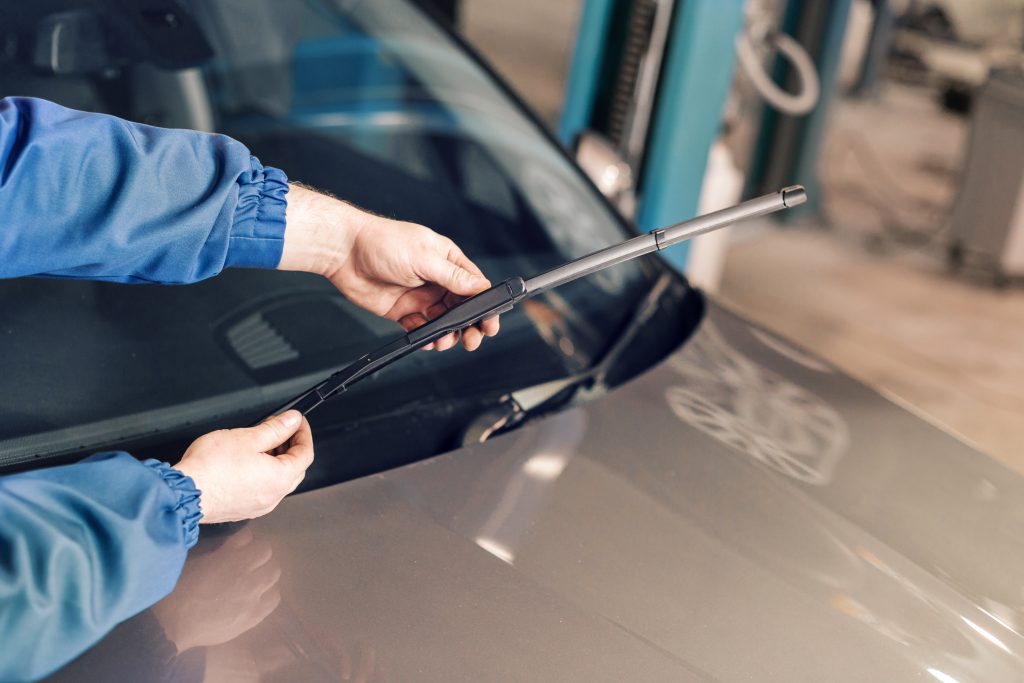The joys of the open road and the sun beaming down its warm rays may be a common sight on television or in Hollywood films, but these days are few and far between across the UK. The stereotype of grey, cloudy skies and the constant patter of rain may be exaggerated, but no doubt it’s based in fact. Manchester, for example, experiences 152 days of rainfall per year, on average.
What’s a driver to do when vision is obscured? Windscreen wipers are devices used on nearly all motor vehicles in the UK and elsewhere, and no doubt you’ve used them whilst driving on more than one occasion.
This article will outline windscreen wipers in the UK, why you need them in good working condition, how to replace them, and how to go about windscreen wiper repair.
How do windscreen wipers work?
Most windscreen wipers are quite similar in how they operate, so we’ll outline how a typical windscreen wiper works. If your vehicle uses proprietary windscreen wipers, consult your vehicle owner’s manual for installation, maintenance, or replacement, or contact a glazier in your post code for more information.
A typical windscreen wiper uses a metal arm which pivots from one end attached to the vehicle. The other end holds a rubber (sometimes silicone) blade. A windscreen wiper motor powers the arm in a back and forth motion, whereby the windscreen wiper blade pushes away rain, snow, or debris from the windscreen in order to improve the driver’s visibility.
Nearly all vehicles in the UK use windscreen wipers which have adjustable speed settings, as well as continuous or intermittent options depending on the precipitation and driver’s preference.
Windscreen wipers are most commonly found on the front windscreen, but some vehicles use rear window windscreen wipers and/or headlight wipers, as well.
Windscreen wiper blades – what you need to know
Windscreen wiper blades are all fairly similar in their manufacture, but they are certainly not a one-size-fits-all solution for all vehicles. In other words, they all tend to be made from similar materials, but their length and installation will vary depending on your specific vehicle.
A few things to bear in mind when looking to purchase new windshield wipers or wiper blades:
- Windscreen wiper blades are sold in lengths between 30-76 cm. Longer blades are also sold in increments of 5 cm.
- A typical passenger vehicle’s wide angle is about 67 degrees.
- The windscreen wiper motor and pivot assembly are typically made of galvanised steel.
- The windscreen wiper arm frame is typically made of aluminium.
- The windscreen wiper blades are typically made of natural rubber or a synthetic compound.
- Silicone blades generally offer superior durability and performance over rubber, as well as better resistance to UV rays, heat, and cold.
- Plastic or rubber are used for bushings and connection points.
- Windshield wipers are amongst the most reliable components of modern motor vehicles, but they nevertheless require replacing every so often.
What are the best windscreen wipers?
The best windscreen wipers will keep away rain, snow, dirt, and debris from the vehicle’s windscreen without skipping, streaking, splitting, or squeaking as they wipe. If your windscreen wiper is unable to reliably perform these actions and is exhibiting these behaviours, it’s a sign that they should be repaired or replaced altogether.
For this reason, it’s best to be observant whenever you use your windscreen wipers and to detect these signs before they turn into a more serious problem. A small rock or sharp object lodged between the rubber wiping blade and the windscreen has the potential to streak across the windscreen, causing scratches or hairline cracks along the windscreen.
Even a single hairline crack can quickly turn into a spiderweb and subsequently lead to shattering, so don’t underestimate the potential for damage. Quality windscreen wipers will provide your windscreen with superior protection and lower the possibility of scratching or cracking.
How do I know what windscreen wipers I need?
Windscreen wiper blade manufacturers try to make things easy peasy for vehicle owners in need of replacement blades. The box that contains the product will typically have a numerical product code. Your car owner’s manual should also contain a product code for windscreen wipers. If the numbers match, the windscreen wipers are compatible and suitable for your vehicle.
Now, that’s all fine for replacing your windscreen wiper blades with the same ones later on. These are called conventional wiper blades. If you’re feeling like an upgrade, however, there are options on the market that offer superior durability, aerodynamics, and wiping angles. These are called flat wiper blades.
Upgrading to flat wiper blades is a sensible alternative, but shopping for a product that is compatible with your vehicle may be a little more challenging. If in doubt, speak to a shopkeeper and provide them with the make and model of your vehicle for an ideal alternative to conventional wiper blades.
How long do windscreen wipers last?
Most windscreen wiper blades have a usable lifespan of up to 12 months. In theory, that should suffice for up to 1.5 million wipes. In the real world, you may need to change them every 6-12 months depending on circumstances.
If you’re having problems with visibility, or you’re experiencing juddering on the screen, a squeaking noise, the blades are leaving streaks, or if the blades have notches upon running a finger down them, it’s a good sign that your windscreen wiper blades are worn out.
Is it easy to replace windscreen wipers?
Replacing windscreen wipers is quite easy to do yourself, but it’s always wise to exercise caution and allow a professional to install it if in doubt.
Concerning replacement blades, either use the product code mentioned in the vehicle owner’s manual or measure the blades yourself to determine which replacement blades to purchase. Be careful: left and right blades are often different sizes, so measure each one individually.
Installation should only take a few minutes and does not require any tools. The old blades can be removed by raising the wiper arm and disconnecting the blade. The new blades can be simply locked into place without much effort. Most blades will make a clicking sound when they’ve been properly inserted into the wiper arm.
Replacing windscreen wipers altogether, i.e. the blade arm, windscreen wiper motor, or the pivot arm, is not so easy to do yourself. These components are quite durable and shouldn’t require constant repairs, but if you find yourself with worn out or damaged components then it’s best to leave this to a professional glazier or mechanic.
Can you fail an MOT for windscreen wipers?
The annual MOT test for most vehicles that are at least three years old is important for keeping roadworthy vehicles on the road and potentially dangerous ones off. Windscreen wipers are an important part of the MOT test, so it’s critical that you’re using quality windscreen wipers that show no signs of damage themselves and that the windscreen is also in good working condition.
Yes, you can fail an MOT test for windscreen wipers. Without an MOT, drivers can incur fines of up to £1,000, but more importantly, they may endanger themselves or others on the road. That’s why MOT considers windscreen wipers and windscreens so important.
Here’s what you need to know about the MOT test as pertains to windscreen wipers:
- If the windscreen wipers are missing, worn out, or are loose such that the driver’s visibility is obscured, the car will fail the MOT.
- If the windscreen itself is chipped or cracked over 10 cm within the driver’s direct line of vision (above the steering wheel) or 40 cm elsewhere on the windscreen, the car will fail the MOT.
- Rear windscreen wipers are not part of the MOT. If your vehicle has rear windscreen wipers and you’ve chosen to remove them for the test, ensure that the connecting arm is not protruding from its resting place (which could cause injury).
With regards to the second point, the MOT recognises and refers to the driver’s line of vision as Zone A. This area is the area of the windscreen centred on the centre of the steering wheel and extending outwards in an area 29 cm wide (or 14.5 cm on either side of the steering wheel). This area may not have any cracks greater than 10 cm.
What to do if windscreen wipers fail whilst driving
In all likelihood, the moment you detect a problem with your windscreen wipers will be whilst driving. That’s unfortunate, because they may fail exactly when you need them most. Faults in windshield wipers are seldom due to the blades, but rather due to the windscreen wiper motor malfunctioning.
Although the motor is encased in protective metal to resist the elements, internal problems may be preventing the wipers from doing their job. There are two main causes of failure with the motor: a faulty fuse or an open circuit.
Fuses can be tested with some auto mechanic equipment, but generally, they wear out on older windscreen wiper motors. Consult your vehicle owner’s manual to find out where the fuse is located and remove it. You may find that there are broken wire or char marks inside, which are sure signs of a blown fuse.
If your motor has recently been replaced, the problem is likely an open circuit. An open circuit is simply a broken wire within the assembly. Whether this was a manufacturer defect or for whatever other reason, this can be repaired by visiting a glazier or auto mechanic near you.
Should I lubricate windscreen wipers?
Lubricating windscreen wipers is perfectly safe and it’s also a good habit for stretching out the lifespan of your windscreen wiper blades. Moreover, it also provides an opportunity to inspect for rocks or dirt that may have become lodged between the windscreen and the blades. Removing debris from the blades ensures that your windscreen will not sustain damage from rocks streaking across or cracking the windscreen.
Start by applying soap and warm water to the windscreen wiper blades with a microfibre cloth or soft sponge. This will remove much of the built-up dirt and debris. Then, rinse the windshield wiper blades with a bit of water.
After the blades have been thoroughly cleaned, apply a spray silicone lubricant (available at most auto shops) directly to the blades, coating them on all sides with the lubricant. The silicone acts to dampen squeaking noises and to permit the blades to travel seamlessly and smoothly across the windscreen.
You may need to apply silicone lubricant a few times throughout colder months for best effect. Also bear in mind that if your windscreen wiper blades are squeaking in the first place, it’s a possible sign that they need to be replaced.
Windscreen wipers are simple yet vital
Windscreen wipers are a simple yet important component of a roadworthy vehicle in the UK. While replacing blades every 6-12 months is a straightforward affair, problems with the motor or other components can cause headaches, especially whilst driving in the rain.
Moreover, poorly functioning or worn out windscreen wipers can cause significant damage to the windscreen, leading to cracks and broken windscreens. myWindscreen is an online marketplace of approved auto glaziers and windscreen repair experts in the UK.






